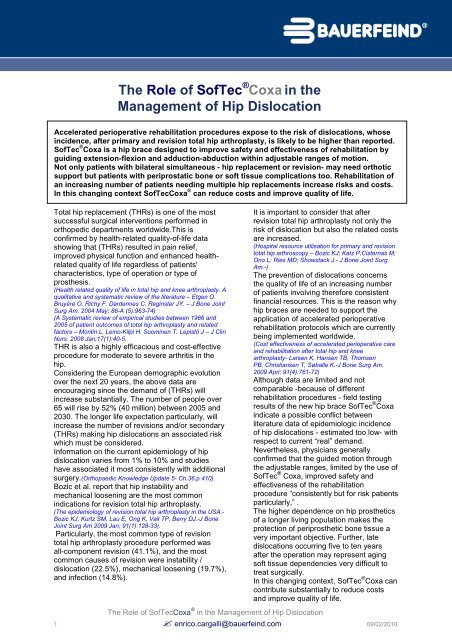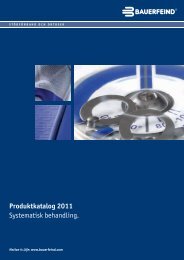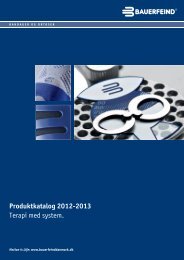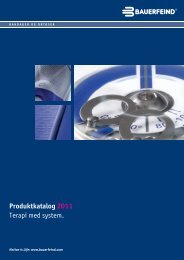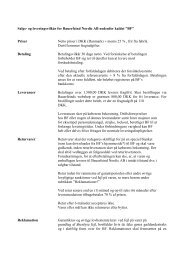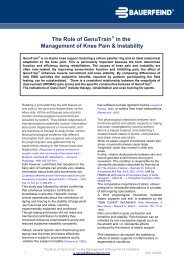The Role of SofTec® Coxa (PDF, 118 KB - Bauerfeind
The Role of SofTec® Coxa (PDF, 118 KB - Bauerfeind
The Role of SofTec® Coxa (PDF, 118 KB - Bauerfeind
You also want an ePaper? Increase the reach of your titles
YUMPU automatically turns print PDFs into web optimized ePapers that Google loves.
<strong>The</strong> <strong>Role</strong> <strong>of</strong> S<strong>of</strong>Tec ® <strong>Coxa</strong> in the<br />
Management <strong>of</strong> Hip Dislocation<br />
Accelerated perioperative rehabilitation procedures expose to the risk <strong>of</strong> dislocations, whose<br />
incidence, after primary and revision total hip arthroplasty, is likely to be higher than reported.<br />
S<strong>of</strong>Tec ® <strong>Coxa</strong> is a hip brace designed to improve safety and effectiveness <strong>of</strong> rehabilitation by<br />
guiding extension-flexion and adduction-abduction within adjustable ranges <strong>of</strong> motion.<br />
Not only patients with bilateral simultaneous - hip replacement or revision- may need orthotic<br />
support but patients with periprostatic bone or s<strong>of</strong>t tissue complications too. Rehabilitation <strong>of</strong><br />
an increasing number <strong>of</strong> patients needing multiple hip replacements increase risks and costs.<br />
In this changing context S<strong>of</strong>Tec<strong>Coxa</strong> ® can reduce costs and improve quality <strong>of</strong> life.<br />
Total hip replacement (THRs) is one <strong>of</strong> the most<br />
successful surgical interventions performed in<br />
orthopedic departments worldwide.This is<br />
confirmed by health-related quality-<strong>of</strong>-life data<br />
showing that (THRs) resulted in pain relief,<br />
improved physical function and enhanced healthrelated<br />
quality <strong>of</strong> life regardless <strong>of</strong> patients'<br />
characteristics, type <strong>of</strong> operation or type <strong>of</strong><br />
prosthesis.<br />
(Health related quality <strong>of</strong> life in total hip and knee arthroplasty. A<br />
qualitative and systematic review <strong>of</strong> the literature – Etgen O.<br />
Bruyére O. Richy F. Dardennes C. Reginster JY. – J Bone Joint<br />
Surg Am. 2004 May; 86-A (5):963-74)<br />
(A Systematic review <strong>of</strong> empirical studies between 1966 and<br />
2005 <strong>of</strong> patient outcomes <strong>of</strong> total hip arthroplasty and related<br />
factors – Montin L, Leino-Kilpi H. Suominen T. Lepistö J – J Clin<br />
Nurs. 2008 Jan;17(1):40-5.<br />
THR is also a highly efficacious and cost-effective<br />
procedure for moderate to severe arthritis in the<br />
hip.<br />
Considering the European demographic evolution<br />
over the next 20 years, the above data are<br />
encouraging since the demand <strong>of</strong> (THRs) will<br />
increase substantially. <strong>The</strong> number <strong>of</strong> people over<br />
65 will rise by 52% (40 million) between 2005 and<br />
2030. <strong>The</strong> longer life expectation particularly, will<br />
increase the number <strong>of</strong> revisions and/or secondary<br />
(THRs) making hip dislocations an associated risk<br />
which must be considered.<br />
Information on the current epidemiology <strong>of</strong> hip<br />
dislocation varies from 1% to 10% and studies<br />
have associated it most consistently with additional<br />
surgery.(Orthopaedic Knowledge Update 5- Ch.36.p 410).<br />
Bozic et al. report that hip instability and<br />
mechanical loosening are the most common<br />
indications for revision total hip arthroplasty.<br />
(<strong>The</strong> epidemiology <strong>of</strong> revision total hip arthroplasty in the USA.-<br />
Bozic KJ, Kurtz SM, Lau E, Ong K, Vail TP, Berry DJ.-J Bone<br />
Joint Surg Am 2009 Jan; 91(1):128-33).<br />
Particularly, the most common type <strong>of</strong> revision<br />
total hip arthroplasty procedure performed was<br />
all-component revision (41.1%), and the most<br />
common causes <strong>of</strong> revision were instability /<br />
dislocation (22.5%), mechanical loosening (19.7%),<br />
and infection (14.8%).<br />
<strong>The</strong> <strong>Role</strong> <strong>of</strong> S<strong>of</strong>Tec<strong>Coxa</strong> ® in the Management <strong>of</strong> Hip Dislocation<br />
It is important to consider that after<br />
revision total hip arthroplasty not only the<br />
risk <strong>of</strong> dislocation but also the related costs<br />
are increased.<br />
(Hospital resource utilisation for primary and revision<br />
total hip arthroscopy – Bozic KJ; Katz P;Cisternas M;<br />
Ono L; Ries MD; Showstack J.- J Bone Joint Surg<br />
Am.-)<br />
<strong>The</strong> prevention <strong>of</strong> dislocations concerns<br />
the quality <strong>of</strong> life <strong>of</strong> an increasing number<br />
<strong>of</strong> patients involving therefore consistent<br />
financial resources. This is the reason why<br />
hip braces are needed to support the<br />
application <strong>of</strong> accelerated perioperative<br />
rehabilitation protocols which are currently<br />
being implemented worldwide.<br />
(Cost effectiveness <strong>of</strong> accelerated perioperative care<br />
and rehabilitation after total hip and knee<br />
arthroplasty- Larsen K, Hansen TB, Thomsen<br />
PB, Christiansen T, Søballe K.-J Bone Surg Am.<br />
2009 Apri; 91(4):761-72)<br />
Although data are limited and not<br />
comparable -because <strong>of</strong> different<br />
rehabilitation procedures - field testing<br />
results <strong>of</strong> the new hip brace S<strong>of</strong>Tec ® <strong>Coxa</strong><br />
indicate a possible conflict between<br />
literature data <strong>of</strong> epidemiologic incidence<br />
<strong>of</strong> hip dislocations - estimated too low- with<br />
respect to current “real” demand.<br />
Nevertheless, physicians generally<br />
confirmed that the guided motion through<br />
the adjustable ranges, limited by the use <strong>of</strong><br />
S<strong>of</strong>Tec ® <strong>Coxa</strong>, improved safety and<br />
effectiveness <strong>of</strong> the rehabilitation<br />
procedure “consistently but for risk patients<br />
particularly,” .<br />
<strong>The</strong> higher dependence on hip prosthetics<br />
<strong>of</strong> a longer living population makes the<br />
protection <strong>of</strong> periprosthetic bone tissue a<br />
very important objective. Further, late<br />
dislocations occurring five to ten years<br />
after the operation may represent aging<br />
s<strong>of</strong>t tissue dependencies very difficult to<br />
treat surgically.<br />
In this changing context, S<strong>of</strong>Tec ® <strong>Coxa</strong> can<br />
contribute substantially to reduce costs<br />
and improve quality <strong>of</strong> life.<br />
1 enrico.cargalli@bauerfeind.com 09/02/2010
S<strong>of</strong>Tec ® <strong>Coxa</strong><br />
Product Features<br />
Hip brace system made <strong>of</strong> a semi-rigid shell<br />
supporting an adjustable left or right hinge<br />
- fixed by external knitted fabric belts – to<br />
pelvis and thigh.<br />
Two duraluminium hinges -centred on the<br />
trochanter - are available for right and / or left<br />
THRs (total hip replacements). Flexion-<br />
Extension are adjustable between -10° and<br />
+ 90° by an easy pin-lock scale while<br />
Adduction-Abduction are adjustable<br />
continuously.<br />
<strong>The</strong> anatomically shaped pelvic polyurethane<br />
shell allows for adaptable and safe positioning<br />
<strong>of</strong> the brace on the iliac crest. Circumferential<br />
adaptation is achieved inserting pins in suitable<br />
holes corresponding to patient size.<br />
<strong>The</strong> shell is fixed to the external knitted fabric<br />
belt by a robust Velcro harness.<br />
<strong>The</strong> external belts are made <strong>of</strong> moisture<br />
dissipating knitted fabric and both pelvic and<br />
thigh fastening components are adjustable and<br />
fixed by double Velcro straps. <strong>The</strong> pelvic<br />
fixation das not interferes with the area <strong>of</strong><br />
surgical intervention while supporting the<br />
hinge-guided motion.<br />
<strong>The</strong> specific features <strong>of</strong> these three elements<br />
make the system much more then just the sum<br />
<strong>of</strong> its components.<br />
Proportion and design allows a perfect<br />
adaptation and the length <strong>of</strong> the adjustable<br />
hinges provides for the necessary robustness.<br />
It is mandatory that patients experience<br />
security and protection, during post OPrehabilitation.<br />
This perception goes beyond the<br />
anatomic fitting <strong>of</strong> the brace and can only be<br />
achieved by perfect integration <strong>of</strong> the system<br />
to the patient. <strong>The</strong> low weight <strong>of</strong> S<strong>of</strong>Tec ® <strong>Coxa</strong><br />
represents just one <strong>of</strong> the features making<br />
such integration complete.<br />
S<strong>of</strong>Tec ® <strong>Coxa</strong> is available in 3 sizes (small,<br />
medium, large), depending on the<br />
circumference and with 2 different joints fitting<br />
female or male morphology.<br />
<strong>The</strong> <strong>Role</strong> <strong>of</strong> S<strong>of</strong>Tec<strong>Coxa</strong> ® in the Management <strong>of</strong> Hip Dislocation<br />
Adjustable hinge<br />
Semi-rigid shell<br />
Knitted fabric support<br />
2 enrico.cargalli@bauerfeind.com 09/02/2010
Indications<br />
Prevention <strong>of</strong> dislocation<br />
Total hip replacement surgery<br />
Total hip revision surgery<br />
Hip spacer in two-stage revision procedures<br />
Femoral head resection (Girdlestone arthroplasty)<br />
Reducing the load on the hip joint and securing the femoral head in the<br />
acetabulum socket is the goal <strong>of</strong> S<strong>of</strong>Tec ® <strong>Coxa</strong> as well as a requirement<br />
for (most <strong>of</strong>) the above indications.<br />
Particularly in cases <strong>of</strong> bilateral intervention the contribution <strong>of</strong> S<strong>of</strong>Tec ® <strong>Coxa</strong><br />
could be substantial.<br />
Compensating abductors muscle weakness after hip artroplasty is also<br />
necessary to stabilize the hip in the frontal plane during unilateral stance,<br />
including the stance phase <strong>of</strong> walking.<br />
<strong>The</strong> biomechanical principle <strong>of</strong> S<strong>of</strong>Tec ® <strong>Coxa</strong> is depicted in the above figure.<br />
By fastening thigh and pelvis to the lateral hinge, S<strong>of</strong>Tec ® <strong>Coxa</strong> prevents the<br />
gravity <strong>of</strong> the mass superincoumbent to the hip joint to drop the pelvis on the<br />
unsupported side. <strong>The</strong> resultant force, transferred by the hinge to the trocanther,<br />
achieves the double effect <strong>of</strong> reducing abductor force and preventing hip joint<br />
dislocation during unilateral stance.<br />
Hip arthrodesis may change the body<br />
mechanical axis causing compensatory<br />
pelvis and spine behaviour.<br />
In cases <strong>of</strong> arthrodesis with limited or<br />
moderate adduction (A) trunk translation is<br />
neutral and the centre <strong>of</strong> gravity remains in<br />
S2.<br />
<strong>The</strong> gravity line however changes<br />
remarkably when pelvis and spine<br />
compensate arthrodesis with important<br />
adductions as (B) and (C).<br />
<strong>The</strong> lumbo-sacral height <strong>of</strong> S<strong>of</strong>Tec ® <strong>Coxa</strong><br />
can prevent this condition involving gait<br />
patterns which cannot be tolerated over<br />
long periods (Duchenne limp;<br />
Trendelenburg gait or a gluteus mediums<br />
limp)<br />
Conservative rehabilitation <strong>of</strong> moderate coxarthrosis and / or osteoporosis also represents a very<br />
important indication <strong>of</strong> S<strong>of</strong>Tec ® <strong>Coxa</strong>.<br />
<strong>The</strong> peak loading <strong>of</strong> the hip joint at higher gait velocity however suggest that patients with incipient or<br />
advanced osteoporosis should be advised against unprotected fast walking, running or jogging.<br />
<strong>The</strong> <strong>Role</strong> <strong>of</strong> S<strong>of</strong>Tec<strong>Coxa</strong> ® in the Management <strong>of</strong> Hip Dislocation<br />
3 enrico.cargalli@bauerfeind.com 09/02/2010
Conclusion<br />
<strong>The</strong> increasing life expectancies will substantially increase the demand for total hip replacement<br />
in patients + 65. This fact along with a life style characterized by more mobility represents a<br />
growing risk <strong>of</strong> hip joint dislocations.<br />
S<strong>of</strong>Tec ® <strong>Coxa</strong> represents a proportionate and efficient answer to the patients and physicians<br />
demand <strong>of</strong> protection during perioperative rehabilitation. This phase, depending on the age <strong>of</strong><br />
patients, is quite variable but can be also long.<br />
S<strong>of</strong>Tec ® <strong>Coxa</strong> exploits a basic biomechanical principle though realized with efficiency and comfort<br />
Adaptation is easy but the required precision makes the skill <strong>of</strong> an orthopaedic technician<br />
necessary.<br />
References<br />
Musculoskeletal Biomechanics –Brinckmann P., Frobin W., Leivseth G.-Thieme<br />
J Bone Joint Surg Am. 2003 Jan;85-A(1):27-32.<br />
Rates and outcomes <strong>of</strong> primary and revision total hip replacement in the United States<br />
medicare population.<br />
Mahomed NN, Barrett JA, Katz JN, Phillips CB, Losina E, Lew RA, Guadagnoli E, Harris<br />
WH, Poss R, Baron JA.<br />
Can J Surg. 2008 Dec;51(6):428-36.<br />
Patient characteristics affecting the prognosis <strong>of</strong> total hip and knee joint arthroplasty: a<br />
systematic review.<br />
Santaguida PL, Hawker GA, Hudak PL, Glazier R, Mahomed NN, Kreder HJ, Coyte<br />
PC, Wright JG.<br />
J Clin Nurs. 2008 Jan;17(1):40-5.<br />
A systematic review <strong>of</strong> empirical studies between 1966 and 2005 <strong>of</strong> patient outcomes <strong>of</strong> total<br />
hip arthroplasty and related factors.<br />
Montin L, Leino-Kilpi H, Suominen T, Lepistö J.<br />
<strong>The</strong> <strong>Role</strong> <strong>of</strong> S<strong>of</strong>Tec<strong>Coxa</strong> ® in the Management <strong>of</strong> Hip Dislocation<br />
4 enrico.cargalli@bauerfeind.com 09/02/2010
J Bone Joint Surg Am. 2004 May;86-A(5):963-74.<br />
Health-related quality <strong>of</strong> life in total hip and total knee arthroplasty. A qualitative and<br />
systematic review <strong>of</strong> the literature.<br />
Ethgen O, Bruyère O, Richy F, Dardennes C, Reginster JY<br />
J Bone Joint Surg Am. 2009 Apr;91(4):761-72.<br />
Cost-effectiveness <strong>of</strong> accelerated perioperative care and rehabilitation after total hip and knee<br />
arthroplasty.<br />
Larsen K, Hansen TB, Thomsen PB, Christiansen T, Søballe K<br />
J Bone Joint Surg Br. 2009 Apr;91(4):451-8.<br />
Revision following cemented and uncemented primary total hip replacement: a seven-year<br />
analysis from the New Zealand Joint Registry.<br />
Hooper GJ, Rothwell AG, Stringer M, Frampton C.<br />
J Bone Joint Surg Am. 2009 Jan;91(1):128-33.<br />
<strong>The</strong> epidemiology <strong>of</strong> revision total hip arthroplasty in the United States.<br />
Bozic KJ, Kurtz SM, Lau E, Ong K, Vail TP, Berry DJ<br />
Chir Narzadow Ruchu Ortop Pol. 2008 May-Jun;73(3):163-6.Links<br />
[Elective total hip arthroplasty for patients 75 years <strong>of</strong> age and older]<br />
[Article in Polish]<br />
Dorman T, Adamczyk E, Synder M, Sibiński M.<br />
J Bone Joint Surg Am. 2005 Mar;87(3):570-6.<br />
Hospital resource utilization for primary and revision total hip arthroplasty.<br />
Bozic KJ, Katz P, Cisternas M, Ono L, Ries MD, Showstack J.<br />
<strong>The</strong> <strong>Role</strong> <strong>of</strong> S<strong>of</strong>Tec<strong>Coxa</strong> ® in the Management <strong>of</strong> Hip Dislocation<br />
5 enrico.cargalli@bauerfeind.com 09/02/2010
Ned Tijdschr Geneeskd. 2007 Sep 1;151(35):1928-34.Links<br />
Comment in:<br />
Ned Tijdschr Geneeskd. 2007 Sep 1;151(35):1915-7.<br />
[Complications within two years after revision <strong>of</strong> total hip prostheses]<br />
[Article in Dutch]<br />
Witjes S, Schrier JC, Gardeniers JW, Schreurs BW.<br />
Clin Orthop Relat Res. 2006 Jun;447:24-7.Links<br />
Dislocation <strong>of</strong> the hip after reimplantation for infection: an analysis <strong>of</strong> risk factors.<br />
Hartman CW, Garvin KL.<br />
J Bone Joint Surg Am. 2002 Oct;84-A(10):1788-92.<br />
Dislocation after revision total hip arthroplasty : an analysis <strong>of</strong> risk factors and treatment<br />
options.<br />
Alberton GM, High WA, Morrey BF<br />
J Bone Joint Surg Br. 2009 Mar;91(3):321-6.<br />
Outcome <strong>of</strong> treatment for dislocation after primary total hip replacement.<br />
Kotwal RS, Ganapathi M, John A, Maheson M, Jones SA.<br />
Hip Int. 2009 Apr-Jun;19(2):109-13.<br />
Revision for recurrent dislocation <strong>of</strong> total hip replacement.<br />
Rogers M, Blom AW, Barnett A, Karantana A, Bannister GC.<br />
<strong>The</strong> <strong>Role</strong> <strong>of</strong> S<strong>of</strong>Tec<strong>Coxa</strong> ® in the Management <strong>of</strong> Hip Dislocation<br />
6 enrico.cargalli@bauerfeind.com 09/02/2010


